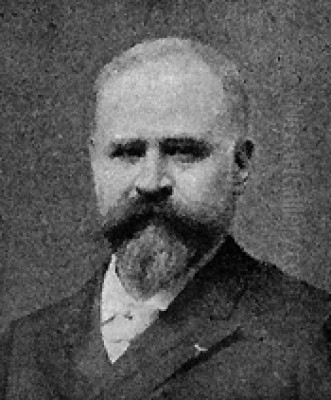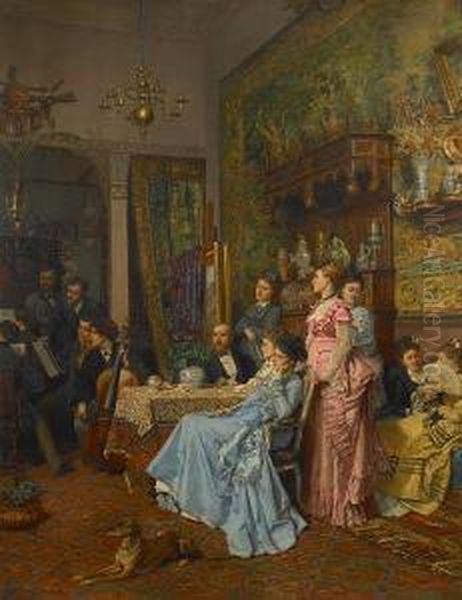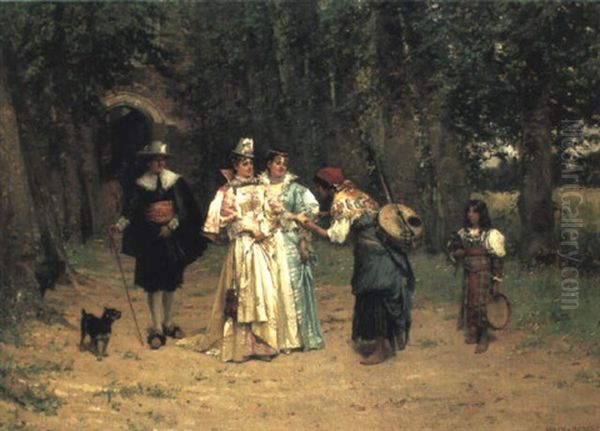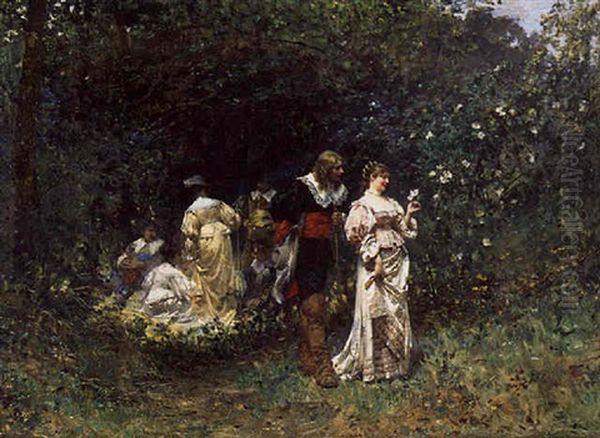
Adrien Moreau stands as a significant figure in French art of the latter half of the 19th century. A painter, sculptor, and illustrator, he navigated the complex artistic landscape of his time, achieving considerable success while developing a distinctive style that blended academic tradition with contemporary sensibilities. His work, often focused on historical genre scenes, particularly the elegant life of French aristocracy in centuries past, found favour with critics, collectors, and the official Salon, earning him numerous accolades throughout his career. This exploration delves into the life, artistic development, key works, and historical context of Adrien Moreau, positioning him within the vibrant and often contentious art world of his era.
Early Life and Artistic Inclinations
Born in Troyes, within the Aube department of the Grand Est region of France, on April 18, 1843, Adrien Moreau entered a world where artistic pursuits were valued. His family background possessed artistic connections, providing an environment that likely nurtured his early inclinations. Before dedicating himself fully to painting and sculpture, Moreau initially trained in a different craft: glassmaking. This early experience, demanding precision and attention to detail, may have subtly informed the meticulous quality often observed in his later paintings, particularly in the rendering of costumes, architecture, and decorative elements.
However, the allure of the fine arts, particularly the vibrant art scene of Paris, proved irresistible. Like many aspiring artists of his generation, Moreau made his way to the capital to seek formal training. This move marked a pivotal step, transitioning him from a regional craftsman to a student within the heart of the French academic system, ready to absorb the lessons of established masters and forge his own artistic identity.
Parisian Training and Stylistic Formation

In Paris, Adrien Moreau enrolled at the prestigious École des Beaux-Arts, the cornerstone of official art education in France. There, he had the opportunity to study under two notable figures of the time: Léon Cogniet and Isidore Pils. Cogniet, known for his Neoclassical and Romantic paintings, and Pils, celebrated for his historical and military genre scenes, represented the established academic tradition. Their studios provided Moreau with a solid foundation in drawing, composition, and the techniques deemed essential for success within the Salon system.
While Moreau absorbed the lessons of his teachers, he demonstrated an independent spirit. The provided information suggests he gradually moved beyond the strict confines of traditional academic pedagogy. He began to synthesize the formal training he received with emerging artistic trends and his own burgeoning interests. This period was crucial for the development of his unique artistic voice, one that would combine historical subject matter with elements drawn from various stylistic currents, including a revived interest in the Rococo, the burgeoning Impressionist movement, and the nostalgic Troubadour style.
Salon Debut and Rising Recognition
The Paris Salon was the preeminent venue for artists seeking recognition and patronage in 19th-century France. Acceptance and success at the Salon could launch a career. Adrien Moreau made his official debut at this critical institution in 1868. His initial submissions were well-received, signaling the arrival of a promising new talent. Critics began to take notice, and his work started to capture the attention of the art-buying public.
His reputation solidified significantly in the 1870s. The year 1873 proved particularly important, with Moreau exhibiting works that garnered considerable acclaim. One notable painting from this period, mentioned with a lengthy biblical title, Puis ce Prophète s’en allait et un lion le rencontra et le tua (Then that Prophet went away, and a lion met him and killed him), demonstrated his ability to tackle serious, albeit perhaps obscure, religious or historical themes. Another key work from the same year, Concert d'artistes dans un atelier d'artiste (Concert of Amateurs in an Artist's Studio), showcased his skill in depicting contemporary or near-contemporary genre scenes with elegance and detail. These successes established Moreau as a regular and respected exhibitor at the Salon.
Artistic Style: A Blend of Influences
Adrien Moreau's mature style is often characterized by its eclectic yet harmonious blend of different artistic influences, reflecting the diverse currents present in late 19th-century French art. He is primarily categorized as a historical and genre painter, but his approach incorporated several distinct stylistic threads.

One significant element was a form of Rococo Revival. Moreau frequently depicted scenes set in the 18th century, evoking the elegance, leisure, and decorative richness associated with the era of artists like Jean-Antoine Watteau and François Boucher. This involved meticulous attention to period costume, furniture, and architectural settings, rendered with a light, often graceful touch.
Simultaneously, Moreau's work shows an awareness of Impressionism, even if he remained fundamentally an academic painter. This might be seen in his handling of light, a brighter palette compared to earlier academic works, and a certain liveliness in brushwork, particularly in outdoor scenes or less formal compositions. However, he never fully embraced the Impressionists' dissolution of form or their focus on fleeting moments of modern life in the same way as Claude Monet or Pierre-Auguste Renoir.
The Troubadour Style (Style Troubadour) also informs some of his work. This earlier 19th-century movement, popular among artists like Jean-Auguste-Dominique Ingres in his youth, involved romanticized depictions of the Middle Ages and Renaissance. Moreau's interest in historical narratives, knights, and courtly life connects to this tradition, imbuing his historical scenes with a sense of nostalgia and romanticism.
Underpinning these stylistic choices was a commitment to Naturalism, understood in the 19th-century context as a desire for realistic depiction and often, an interest in observing different strata of society. While famed for his aristocratic scenes, Moreau also painted peasants and rural life, demonstrating an attention to accurate portrayal and an underlying concern with social observation, a trait shared with contemporaries like Jules Bastien-Lepage.
Themes and Subject Matter
Moreau's thematic range was diverse, though he became particularly known for certain subjects. His early work included religious themes, as evidenced by his 1873 Salon entry. However, he gained greater fame for his historical genre scenes. He showed a marked preference for the 16th and 18th centuries in France, periods associated with the Valois and Bourbon courts, respectively. These eras provided ample opportunity to depict elaborate costumes, courtly manners, romantic intrigues, and moments of historical drama or leisure among the nobility.
His paintings often focus on aristocratic life: elegant figures engaged in conversation in opulent interiors, garden parties, musical performances, carriage rides, or moments of quiet contemplation. Works like A Lady of Quality or The Minuet exemplify this focus on grace, refinement, and the social rituals of the upper classes. He captured the textures of silk and satin, the gleam of polished wood, and the delicate play of light in these sophisticated settings.

Beyond the world of the elite, Moreau also turned his attention to peasant life and rural environments. Paintings such as Rest on the Farm (1876) depict agricultural workers and country scenes. These works often present a somewhat idealized yet sympathetically observed view of rural existence, highlighting the dignity of labor and the connection to the land, contrasting with the artificiality of court life. This thematic duality reflects a broader 19th-century interest in exploring the different facets of French society, from its historical heights to its contemporary foundations. His work consistently reveals an interest in social dynamics and class distinctions, whether implicitly through contrasting depictions or explicitly through narrative scenarios.
Key Representative Works
Several paintings stand out as representative of Adrien Moreau's oeuvre and contributed significantly to his reputation.
Puis ce Prophète s’en allait et un lion le rencontra et le tua (1873): While the specific imagery isn't described in the provided text beyond the title (likely referencing a story from the Book of Kings in the Old Testament), its exhibition in 1873 marks an important early success. It demonstrates his ambition to engage with significant historical or religious narratives, a hallmark of traditional history painting valued by the Salon.
Concert d'artistes dans un atelier d'artiste (1873) / Concert of Amateurs in an Artist's Studio: Also exhibited in 1873, this work likely depicted a more intimate, contemporary, or near-contemporary scene. Such subjects allowed Moreau to showcase his skill in rendering interiors, fabrics, and the interplay of figures in a social setting, highlighting the cultural life of the bourgeoisie or artistic circles. It points towards his strength in genre painting alongside more formal historical subjects.
Repos à la ferme (Rest on the Farm) (1876): This painting earned Moreau a silver medal at the Salon of 1876. It represents his engagement with rural themes and Naturalism. Depicting peasants or farm workers taking a break, the work likely combined realistic observation with a degree of pastoral sentiment, appealing to contemporary tastes for scenes of country life while demonstrating technical skill.
Other typical, though perhaps less documented, works often carry titles suggesting his preferred themes: The Minuet, A Lady of Quality, An Elegant Outing, The Signing of the Marriage Contract. These titles evoke the world of 18th-century elegance and social ritual that became strongly associated with his name. His ability to render these scenes with convincing detail, atmospheric lighting, and narrative charm was central to his appeal.
The Illustrator: Moreau and Literature
Beyond his work as a painter and sculptor, Adrien Moreau was also a prolific and respected illustrator. He lent his talents to editions of works by some of France's most celebrated authors, demonstrating his versatility and his deep engagement with narrative. The provided texts mention his illustrations for literary giants such as Victor Hugo, the towering figure of French Romanticism; Voltaire, the Enlightenment philosopher and writer; and Honoré de Balzac, the master chronicler of French society in La Comédie Humaine.
Illustrating such diverse authors required adaptability and a keen understanding of different historical periods and literary moods. His work likely involved creating images that captured key scenes, characters, and the overall atmosphere of the texts. Specific titles mentioned include Les Fous de Charenton (The Madmen of Charenton) and Les Secrets de Saint-Louis (The Secrets of Saint Louis), suggesting a range from potentially dramatic or psychological subjects to historical narratives. This aspect of his career further cemented his reputation and disseminated his artistic vision to a wider audience through the medium of books.
Context: The Art World of Late 19th-Century France
To fully appreciate Adrien Moreau's career, it's essential to place him within the dynamic and often polarized art world of late 19th-century France. This era witnessed the continued dominance of the Academic tradition, upheld by the École des Beaux-Arts and the official Salon, alongside the rise of revolutionary movements, most notably Impressionism.
The Academic system, represented by powerful figures like Jean-Léon Gérôme, William-Adolphe Bouguereau, and Alexandre Cabanel, emphasized historical subjects, mythological scenes, and portraits executed with meticulous technique and a high degree of finish. Moreau operated largely within this system, achieving success through Salon exhibitions and official recognition. His focus on historical genre painting aligned well with Academic preferences, although his stylistic blend was perhaps more modern than that of the strictest traditionalists.
He can be compared to other successful historical and genre painters of the time. Ernest Meissonier, for instance, was renowned for his incredibly detailed small-scale historical and military scenes, sharing Moreau's commitment to historical accuracy (or perceived accuracy) and technical finesse. James Tissot, though working often in England, depicted scenes of contemporary elegant society with a similar attention to fashion and social nuance, albeit usually in a modern setting.
Meanwhile, the Impressionists – including Claude Monet, Edgar Degas, Pierre-Auguste Renoir, Camille Pissarro, and the English-born Alfred Sisley – were challenging the very foundations of Academic art. They prioritized capturing fleeting moments, the effects of light and atmosphere, and scenes of modern life, often using looser brushwork and brighter palettes. While Moreau incorporated some aspects of Impressionist technique (particularly regarding light and perhaps colour), he remained distinct from the avant-garde, maintaining a commitment to narrative clarity, detailed rendering, and historical subject matter that appealed to the Salon juries and established collectors.
Moreau's interest in Naturalism and peasant scenes connects him to artists like Jules Bastien-Lepage and, to some extent, Jean-François Millet (though Millet's work carries a heavier, more profound social weight). These artists sought to depict rural life with authenticity, contributing to a broader trend that countered the idealized or purely historical focus of some Academic painting.
Moreau and His Contemporaries: Comparisons and Distinctions
While Moreau shared the artistic stage with numerous talented individuals, certain comparisons are particularly illuminating. The mention of Gustave Moreau (1826-1898) requires careful distinction. Despite the shared surname, Adrien and Gustave Moreau represented very different artistic paths. Gustave was a leading figure of Symbolism, creating complex, often enigmatic paintings filled with mythological figures, biblical allegories, and a rich, jewel-like technique. His work explored psychological depth and mystical themes, far removed from Adrien's focus on historical genre and social observation. While both were highly respected, Gustave's influence pointed towards modernist explorations of the subconscious, whereas Adrien remained more grounded in narrative realism and historical evocation. There is no evidence of direct personal rivalry, but they occupied distinct territories within the French art world.
Compared to the meticulous detail of Meissonier, Adrien Moreau's work, while detailed, often possesses a lighter, more fluid touch, perhaps reflecting the influence of Rococo aesthetics and a subtle absorption of Impressionist brushwork. His subject matter, frequently centered on aristocratic leisure, also differed from Meissonier's often more masculine, military, or scholarly themes.
His relationship with artists focused on social realism or peasant life, like Bastien-Lepage or perhaps Léon Lhermitte, is one of shared thematic interest but differing approaches. Moreau's depictions of rural life, while sympathetic, generally lack the starker realism or social commentary found in some works by Bastien-Lepage. Moreau's peasants often fit within a more picturesque or anecdotal framework.
Teachers like Léon Cogniet and Isidore Pils provided Moreau's foundation, but his mature work moved beyond their specific styles. He embraced a wider range of historical periods and incorporated a lighter palette and more varied brushwork than was typical of Cogniet's Neoclassicism or Pils's somewhat darker military scenes. He also taught, encouraging students to explore contemporary themes like landscape and peasant subjects while grounding them in traditional techniques, suggesting a pedagogical approach that valued both heritage and relevance. Other influential teachers and portraitists of the era included figures like Léon Bonnat.
Reception, Criticism, and Honors
Adrien Moreau enjoyed considerable success and positive reception throughout much of his career. His Salon debut was praised, and the critic Joseph Uzanne reportedly called him "one of the greatest genre painters of the day," indicating high esteem early on. His ability to capture the elegance and spirit of past eras, combined with his technical skill, resonated with the tastes of the time. His works were popular not only in France but also attracted international collectors, particularly wealthy Americans seeking sophisticated European art.
He received official recognition in the form of awards. He won silver medals at the prestigious Exposition Universelle (World's Fair) in Paris in both 1889 and 1900. His 1876 Salon success with Rest on the Farm also resulted in a medal. Crowning his career, he was made a Chevalier (Knight) of the Legion of Honour in 1906, the year of his death, a significant state recognition of his contributions to French art and culture.
However, his career was not without criticism or controversy. The very eclecticism of his style, blending Rococo Revival, Impressionistic touches, and Troubadour elements within an academic framework, led some critics to find his work lacking in stylistic consistency. The provided text notes he was even referred to dismissively by some as a "grand malade" ("great invalid" or perhaps "great eccentric"), suggesting his unique blend didn't satisfy purists of any single camp.
Furthermore, his use of historical detail, particularly architectural and decorative elements, was sometimes viewed as "archaeological allegory," potentially implying that his focus on accurate settings occasionally overshadowed the narrative or emotional content, or perhaps challenged strict notions of historical verisimilitude by prioritizing aesthetic effect. This type of critique reflects ongoing debates in the 19th century about the purpose and methods of history painting.
Later Life, Challenges, and Legacy
Moreau's later life included personal and professional challenges. A studio explosion in 1879 reportedly forced an interruption in his work, a significant setback for any artist reliant on consistent production. The death of his wife in 1890 was a profound personal loss, which seems to have found expression in his art. Works from this period, such as Orpheus at the Tomb of Eurydice, are noted as reflecting deeper emotional content and perhaps a turn towards more introspective or melancholic themes, possibly influenced by the concurrent Symbolist movement.
Despite these difficulties, he continued to work and maintain his reputation. The provided information suggests his later years may have been somewhat solitary, with a significant focus on his personal collection and perhaps the creation of a private museum space to house his works. This dedication to preserving his own artistic output indicates a strong sense of his place in art history.
Adrien Moreau died in Paris on February 22, 1906. His works continue to be held in museum collections, including those in Carcassonne, Nantes, and his birthplace, Troyes (referred to as Tréves in one snippet, likely a typo or confusion with Trier/Trèves in Germany; Troyes is the correct location). His legacy rests on his skillful and evocative depictions of historical genre scenes, particularly those capturing the vanished elegance of the French aristocracy. He stands as a successful representative of the Salon artists who adapted academic training to incorporate contemporary influences, creating works that appealed to the tastes of the late 19th century.
Conclusion: An Elegant Chronicler
Adrien Moreau carved a distinct niche for himself within the bustling art world of 19th-century France. As a historical genre painter, sculptor, and illustrator, he achieved significant recognition through his technical proficiency, his engaging narrative subjects, and his ability to evoke the atmosphere of bygone eras, particularly the refined world of the 16th and 18th-century French nobility. His style, a sophisticated blend of academic precision, Rococo grace, Troubadour romanticism, and subtle Impressionist influences, found favour at the Salon and with international collectors.
While sometimes criticized for stylistic eclecticism, Moreau's work consistently demonstrated a high level of craftsmanship and a keen eye for detail, whether depicting courtly rituals or scenes of rural life. He navigated the currents of tradition and modernity, creating a body of work that remains appealing for its elegance, narrative charm, and historical imagination. Mentioned alongside contemporaries ranging from academic giants like Gérôme and Bouguereau to Impressionists like Monet and Sisley, and distinct from Symbolists like Gustave Moreau, Adrien Moreau holds his place as a talented and successful chronicler of history and society, whose paintings offer a captivating window onto the aesthetics and sensibilities of his time.